- Sensitive Ski Lift
- "Most Bizarre Winter"
- Poor Grounding
- The Fix: Miles of Copper
- Better Lightning Protection
- But What about Cost?
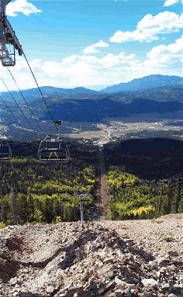 Angel Fire Ski Resort, shown here in mid-summer, offers some of the finest snow conditions to be found anywhere. But winter storms also bring plenty of lightning to northern New Mexico, and power quality problems cost the resort large amounts of lost business during the busiest weekend of the 2000-2001 season.
Angel Fire Ski Resort, shown here in mid-summer, offers some of the finest snow conditions to be found anywhere. But winter storms also bring plenty of lightning to northern New Mexico, and power quality problems cost the resort large amounts of lost business during the busiest weekend of the 2000-2001 season.But up among the Sangre de Cristo Mountains of north central New Mexico, one resort found itself facing large potential losses when an inability to cope with poor power quality shut down its largest lift. The problems were solved with a four-pronged attack: a new computer operating system, replacement of the overhead power line that runs the lift, a complete custom transient-voltage protection system, and the major focal point - installing one of the most extensive copper-based grounding systems in North America.
Angel Fire Resort, located about 25 miles from Taos, is a year-round vacation destination boasting recreational activities that range from golf, water sports and outdoor adventuring to sleigh rides and snowmobiling. The resort's main attractions are, of course, the 68 ski trails that crisscross its slopes. Serving those trails are five chairlifts that haul the resort's thousands of winter visitors from an 8,600-ft (2,621-m) base elevation to the 10,677-ft (3,254-m) summit.
The resort's longest lift, the Chile Express, is an impressive piece of engineering . At 10,000 ft (3,048 m), it is currently one of the longest chairlifts on the North American continent and also one of the longest in the world. Its 36 steel towers support hundreds of chairs on nearly five miles of haul cable. In the trade, the lift is known as a high-speed quad, meaning that it can move passengers at speeds as high as 1,200 ft/min (366 m/min). There are provisions at the upper terminal for pausing and spacing the lift's four-passenger chairs without interrupting service on the lift. A 900-hp, 480-VDC motor backed up by a 1,250-hp diesel-driven emergency generator supplies the power needed to keep the customers moving. The primary motor draws as much as 2,500 A at start-up.
Back to TopSensitive Ski Lift
A modern ski lift like the Chile Express is far more than a rope, a motor, a few pulleys and some chairs. It is, in fact, a piece of sensitive electronic equipment. Why? Because for all-important reasons of passenger safety, the lift is almost entirely computer controlled.
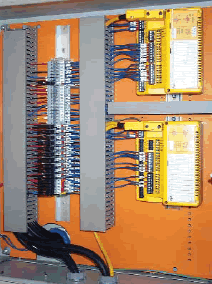 Figure 1a. One of several electrical panels through which are fed the cable leads from the Chile Express lift's many sensors to one of two control computers. For redundancy, both computers operate on three different types of CPU. All that back-up was of little use when poor power quality caused repeated failures in the computer's I/O blocks.
Figure 1a. One of several electrical panels through which are fed the cable leads from the Chile Express lift's many sensors to one of two control computers. For redundancy, both computers operate on three different types of CPU. All that back-up was of little use when poor power quality caused repeated failures in the computer's I/O blocks.The computers contain input/output (I/O)blocks to receive and interpret signals from hundreds of sensors of various types located on and around the lift (Figure 1a). Sensors are interrogated at intervals ranging from a few seconds to one-half minute. The computers use the incoming data to control the lift's speed and chair spacing. Most importantly, they automatically stop the lift should a significant safety-related problem arise. For example, when a sensor signals that wind velocity reaches 40 mph (65 km/h), the computer will annunciate a wind warning; at winds of 50 mph (80 km/h), it shuts the lift down. When "zone" sensors (Figure 1b) in the upper and lower terminal stations find that chair spacing is not what it should be, the computer adjusts lift chair spacing for safer embarking and debarking. The lift also stops when one of dozens of proximity sensors report that the haul rope has shifted position with respect to its support sheaves (Figure 1c).
Unfortunately, sensitive electronic equipment is always vulnerable to poor power quality, and the Chile Express chairlift's control system is no exception. After the lift had been in service for a few years, voltage fluctuations and occasional lost phases in utility power sometimes stopped the lift, annoying -although never endangering -the passengers. Because of its remote location, two circuits, one connected at the base elevation, one at the summit, serve the lift, and load-switching between the two was not uncommon. When voltage sagged, the lift's diesel-powered generator kept things moving, but its manually operated transfer switch meant a few minutes' delay.
 Figure 1b. Dozens of sensors of several types are located along the Chile Express chairlift. The zone sensor shown at the center of this photo checks the position of quad chairs passing through the lift's lower terminal station.
Figure 1b. Dozens of sensors of several types are located along the Chile Express chairlift. The zone sensor shown at the center of this photo checks the position of quad chairs passing through the lift's lower terminal station. 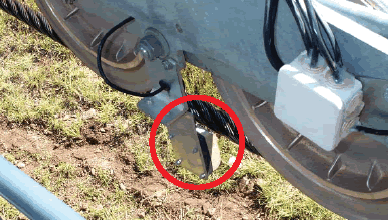 Figure 1c. Proximity sensors (lower center) located on the Chile Express lift's 36 support towers monitor the position of the haul rope with respect to the support sheaves, a potentially life-critical safety factor. Poor power quality and an inadequate grounding system led as many as six of these sensors to fail per day, eventually closing the lift. Cable leads from other sensors on the tower can be seen entering a junction box at upper right.
Figure 1c. Proximity sensors (lower center) located on the Chile Express lift's 36 support towers monitor the position of the haul rope with respect to the support sheaves, a potentially life-critical safety factor. Poor power quality and an inadequate grounding system led as many as six of these sensors to fail per day, eventually closing the lift. Cable leads from other sensors on the tower can be seen entering a junction box at upper right.Lightning was another source of trouble. Northern New Mexico has the dubious distinction of having the second-highest occurrence of thunderstorms in the country according to U.S. Government statistics. The region sees a mean of 110 electrical storms annually, a rate exceeded only in central Florida.
With increasing frequency, voltage surges from both lightning and unsteady utility power caused input/output I/O) blocks in the Chile Express lift's control computers to fail, disrupting communication with the sensors. The sensors themselves also failed regularly, especially proximity sensors located on the one-out-of-five towers fitted with brushes to bleed off and ground static electricity from the haul cable.
All of the lift's towers were originally grounded by means of AWG 1/0 (or smaller) copper cables leading into the ground from bonded connections at the towers' bases (Figure 2). These cables appeared to be simply cable grounds, not connected to made electrodes. Each of the towers thus had an independent ground connection, not connected to the next tower.
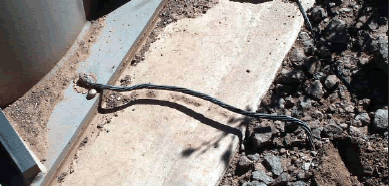
Figure 2. The Chile Express lift's cable support towers were originally grounded with lengths of AWG 1/0 (or smaller). No made electrodes were detected. Although ground resistance was below the 50-ohm limit cited under ANSI B77.1-1999, readings at the 36 towers varied widely. Resulting ground-loop currents were one likely source of the poor power quality that plagued the chairlift's computer control system.
"Most Bizarre Winter
In early 2001, the rate of sensor failures began to accelerate dramatically; the lift maintenance team began to replace proximity sensors and I/O blocks weekly.
Then, on Spring Break Weekend, the resort's busiest period in an otherwise ideal skiing season, Chile Express broke down once too often. "It was the most bizarre winter in my 20 years in the business," recalls Michael Cloutman, Angel Fire Resort's lift maintenance manager. "It was also one of the coldest on record. We had problems with low voltage, and we had problems losing phases. Spring Break was terrible! There were daily outages. We were frying I/O blocks, first from lightning and then from power surges."
The situation got so bad that the tie to one of the two utilities serving the lift was intentionally opened, and the Auxiliary Power Unit was used to keep the lift moving, but at a speed that lengthened the chilly trip to the summit by several minutes. Annoyance turned to anger, and customers began voting with their feet. "The public was disappointed," says Cloutman. "We had the greatest ski conditions I'd ever seen, but what hurt us was the perception that we were down. People just packed up and went home."
But Cloutman and his colleagues soon made an interesting observation: all of the really serious problems with the Chile Express lift started in January and February, when the frost line dropped to its lowest level, five or six feet below grade. The lift's grounding electrode system, such as it was, may not have been installed deep enough. Grounding electrodes rely on moist, electrically conductive soil to work properly. Ice is actually an insulator.
Aha! Might shallow electrodes embedded in frozen earth be the source of the problem? Was it possible that the lift, its large array of sensors and its two sensitive computers were inadequately grounded or maybe even ungrounded when the temperature dropped?
Back to TopPoor Grounding, Plus
For answers, Angel Fire called in Meter Treater of Florida and their team of grounding specialists at PowerQC, Torrance, California. Together they brought years of experience solving grounding and power quality problems for industrial and commercial clients. Stephanie Woodbury of PowerQC agreed that inadequate grounding was probably behind at least some of the Chile Express lift problems. The 36 tower grounds were of variable quality and, as Woodbury soon discovered, connections to the grounding electrode conductors at the lift's upper and lower terminals were also questionable (Figure 3).
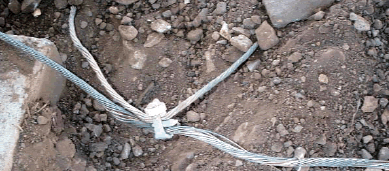
Figure 3. Connections between original grounding electrode conductors at the upper and lower terminal stations were found to be questionable. Some mechanical connectors, while acceptable in many applications, are not recommended for below-grade installations such as this. Corrosion between dissimilar metals, even if only slight, can contribute to high ground resistance values.
Interestingly, the specification that governs the grounding of equipment like ski lifts, ANSI B77.1-1999, Aerial Tramways, Aerial Lifts, Surface Lifts, Tows and Conveyors Safety Requirements, does not specify a specific grounding method, and the edition of the standard in force at the time the lift was built permitted a ground resistance as high as 50 ohms at each tower. That level of resistance is twice the value cited for a made electrode in 250 of the National Electrical Code and more than 10 times the range of values (1-5 ohms) recommended for sensitive electronic equipment in IEEE publications 1100 and 142, the "Emerald" and "Green" books, respectively, or the 2-5 ohm range recommended in TIA/EIA 607, Commercial Building Grounding and Bonding Requirements for Telecommunications.
But shaky grounding alone wasn't the Chile Express's only problem. The "rest of the story" would be found not only in how well the lift's 36 towers were grounded, but how they and the rest of the grounding system, including the computers and sensors, were connected. In addition, power to the lift was supplied through a 30-year-old overhead utility feed located near the lift line - a possible source of induced stray currents.
The towers themselves were not electrically energized but were electrically connected by means of an aluminum messenger wire running from one tower to the next (Figure 4). Bimetallic connections between the messenger wire and the steel towers virtually invited corrosion and high resistance. The steel haul cable provided additional electrical continuity between the towers but, during operation, it generated a static charge of unknown intensity. A third current path between the towers was formed by the shields on a pair of telecommunications cables running the length of the lift. The cables carry signals from the sensors to the control computers and enable voice communications between the upper and lower terminals.
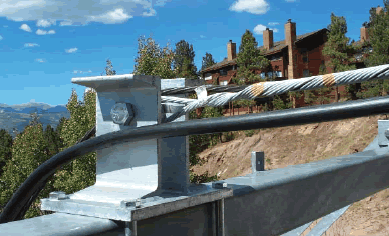
Figure 4. Terminus of the aluminum messenger wire atop a support tower on the Chile Express chairlift. Until extensive modifications were made to the chairlift's grounding system, the messenger wire was the primary electrical connection between 36 individually grounded towers, a situation that helped generate multiple ground loop currents in the system.
As if that hodgepodge of potential ground paths wasn't troublesome enough, Woodbury found that, while the ground resistance levels of most tower grounds met the requirements of ANSI B77.1, they were (not surprisingly) all different. A few grounding conductors were broken or missing.
Combining this finding with the variable resistance offered by the messenger wire connections and the questionable degree to which the haul rope's static charge was being grounded, Woodbury concluded that the lift almost certainly generated a complex array of ground loop currents every time it operated.
The currents alone might be sufficient to cause failure in individual sensors and I/O blocks, especially when the ground loops were superimposed on currents induced by voltage surges from lightning or utility power. In any event, the ground resistance of the entire system was far greater than it should have been for a sensitive computer-based installation. Back to Top
The Fix: Miles of Copper
The solution recommended (and installed) by PowerQC addressed the power quality problems one by one.
- First, all towers were properly grounded using 5-ft (1.5-m) copper-clad steel grounding electrodes set near the tower footers. To ensure that they would extend below the deepest expected frost line, the electrodes were driven from the bottom of 3-ft (1-m) deep trenches. With the electrodes in place, there would be little question that static charges or surges due to lightning strikes would find an easy path to earth. Towers and electrodes were exothermically bonded with bare, stranded AWG 2/0 copper cables (Figures 5a and 5b).
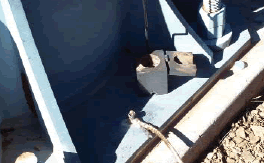 Figure 5a. AWG 2/0 bare copper grounding electrode conductor exothermically welded to a lift tower base. The graphite weld mold can be seen at the upper right of the photograph.
Figure 5a. AWG 2/0 bare copper grounding electrode conductor exothermically welded to a lift tower base. The graphite weld mold can be seen at the upper right of the photograph.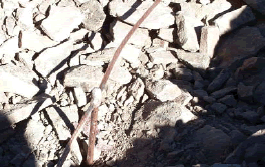 Figure 5b.Grounding electrode conductor exothermically welded to a 5-ft (1.5-m) copper-clad electrode located a few feet from a lift tower. All connections are made using AWG 2/0 bare copper.
Figure 5b.Grounding electrode conductor exothermically welded to a 5-ft (1.5-m) copper-clad electrode located a few feet from a lift tower. All connections are made using AWG 2/0 bare copper.- Electrodes were next bonded to a 10,000-ft (3,000-m) length of AWG 2/0 copper extending along the length of the lift. For protection, the cable was buried in a 3-ft deep trench (Figure 6). Now, all towers would be at very nearly the same ground potential, and the probability that ground loop currents could arise between towers was sharply reduced.
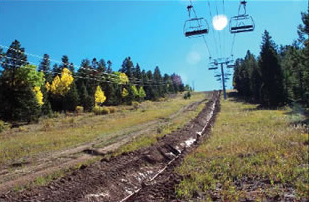 Figure 6. A portion of the 10,000-ft (3,048-m) length of AWG 2/0 bare copper cable connecting all tower grounding electrodes. The cable, visible in the 3-ft (1-m) deep trench, provides a far better electrical connection between the towers than the aluminum messenger wire shown in Figure 4. The low-resistance connection minimizes ground loop currents that formerly plagued the chairlift's control system.
Figure 6. A portion of the 10,000-ft (3,048-m) length of AWG 2/0 bare copper cable connecting all tower grounding electrodes. The cable, visible in the 3-ft (1-m) deep trench, provides a far better electrical connection between the towers than the aluminum messenger wire shown in Figure 4. The low-resistance connection minimizes ground loop currents that formerly plagued the chairlift's control system.- Three-foot (1-m) deep trenches were excavated around the base of both the upper and lower terminal station structures to hold ring grounds made from AWG 2/0 bare copper (Figure 7a). The ring grounds were bonded to the towers and to two 10-ft (3-m) long chemical electrodes positioned horizontally in trenches extending radially outward from the ring-grounds. The chemical rods were surrounded by crushed bentonite clay and thoroughly wetted to ensure good electrical continuity with the surrounding soil (Figure 7b). All connections were exothermically bonded.
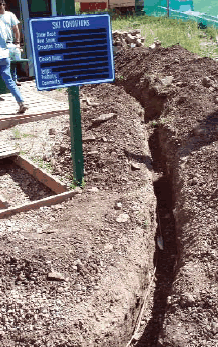 Figure 7a. AWG 2/0 bare copper forming a ring-ground surrounding the Chile Express chairlift's lower terminal station. A similar ring-ground was constructed at the upper terminal station, and both were connected by means of the long copper conductor shown in Figure 6.
Figure 7a. AWG 2/0 bare copper forming a ring-ground surrounding the Chile Express chairlift's lower terminal station. A similar ring-ground was constructed at the upper terminal station, and both were connected by means of the long copper conductor shown in Figure 6.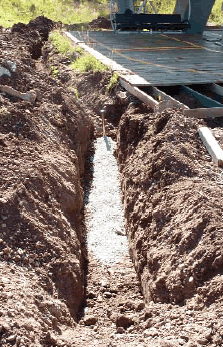 Figure 7b. Overview of one of the chemical electrodes at the lower chairlift terminal station. The electrode is surrounded with bentonite clay to improve electrical continuity with the earth. The ring-ground surrounding the station can be seen at the rear of the scene.
Figure 7b. Overview of one of the chemical electrodes at the lower chairlift terminal station. The electrode is surrounded with bentonite clay to improve electrical continuity with the earth. The ring-ground surrounding the station can be seen at the rear of the scene.- Leads from the ring-grounds were bonded to -in (6.4-mm) copper plates mounted on the interior walls of the control booths located near the terminal stations (Figure 8a). The plates serve as collectors for conductors leading to the control computers and other equipment in the buildings (Figure 8b).
- Finally, the entire grounding system was connected to service entrances at the upper and lower terminal stations. A complete custom-built transient voltage surge suppressor (TVSS) designed by MT-i was installed to protect against voltage transients. Additional TVSS units guard the 24-V communications system.
- In addition, the 30-year-old overhead utility feed was replaced with a new, buried line with adequate size for the lift's power needs.
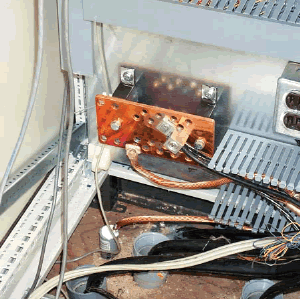 Figure 8a. 1/4-in (6.4-mm) thick copper plates serve as grounding conductor collectors in control buildings at the upper and lower chairlift stations. Bare, stranded AWG 2/0 copper (bottom of photograph) connects to the ring-ground surrounding the station. Additional leads (not shown) connect to sensitive electronic equipment in the building and to a ground-to-neutral bus located at the service entrance panel.
Figure 8a. 1/4-in (6.4-mm) thick copper plates serve as grounding conductor collectors in control buildings at the upper and lower chairlift stations. Bare, stranded AWG 2/0 copper (bottom of photograph) connects to the ring-ground surrounding the station. Additional leads (not shown) connect to sensitive electronic equipment in the building and to a ground-to-neutral bus located at the service entrance panel. Figure 8b. One of two computers that control the Chile Express chairlift at Angel Fire Ski Resort. For safety, each computer operates on three different types of CPUs.
Figure 8b. One of two computers that control the Chile Express chairlift at Angel Fire Ski Resort. For safety, each computer operates on three different types of CPUs.Better Lightning Protection
To protect the chairlift's control system from lightning, the superstructure atop each tower was fitted with six Franklin-type air terminals (Figure 9). The steel towers themselves serve as down conductors. Should lightning strike anywhere along the lift, it sees a continuous low-resistance electrical path to a grounding electrode at the nearest tower.
To ensure optimum voice and data communications, two pre-existing 25-pair telecommunications cables were replaced with a single improved 50-pair cable. The cable's shield was securely grounded by bonding it to the individual towers, the messenger wire and the upper and lower terminal structures (Figure 10).
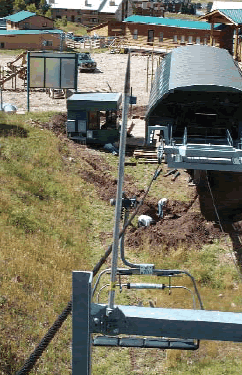 Figure 9. One of six Franklin rods (air terminals) mounted atop each of the Chile Express chairlift's 36 cable support towers. The steel towers themselves serve as down-conductors. A portion of the ring-ground surrounding the chairlift's lower terminal station can be seen in the distance.
Figure 9. One of six Franklin rods (air terminals) mounted atop each of the Chile Express chairlift's 36 cable support towers. The steel towers themselves serve as down-conductors. A portion of the ring-ground surrounding the chairlift's lower terminal station can be seen in the distance.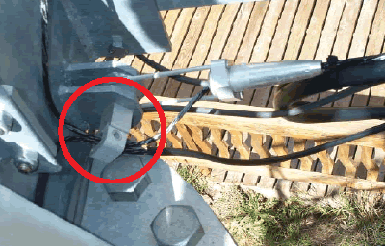 Figure 10. Typical grounding connection between the shield of the chairlift's 50-pair telecommunications cable (black cable, right) and one of the towers. The mechanical setscrew-type connection is seen at the left.
Figure 10. Typical grounding connection between the shield of the chairlift's 50-pair telecommunications cable (black cable, right) and one of the towers. The mechanical setscrew-type connection is seen at the left.But What about Cost?
Two miles of AWG 2/0 is a lot of copper; the Chile Express's new grounding system is larger than those found on many buildings. Yet, the resort's owners consider its cost approximately $65,000 including construction labor, materials and consultants' fees) to be very modest in comparison with the improved safety it provides to the chairlift's passengers. And, compared with the value of the equipment the system protects and the cost of business lost before the system was installed it's downright cheap.
"Just run the numbers," says Jon Mahanna, Angel Fire's director of resort operations. "When the Chile Express went down during Spring Break in 2001, the resort lost a significant amount of income. Add the income lost at the resort's hotel and its gift shop and restaurants, plus good will and spin-off losses to the rest of the community's merchants, and pretty soon we're talking about some serious money.
"We don't ever want to face those kinds of potential losses again, and we see our investment in a few miles of heavy copper cable as the most cost-effective insurance we could buy."
Low cost, high reliability, maximum safety: not a bad return indeed.
The Principals
 Stephanie Woodbury is owner and technical director or PowerQC, an electrical consulting firm located in Torrance, California. PowerQC specializes in grounding system design and testing, GPR studies and reports, and power quality analysis. PowerQC can be reached at (310) 722-1602 and at http://www.powerqc.com.
Stephanie Woodbury is owner and technical director or PowerQC, an electrical consulting firm located in Torrance, California. PowerQC specializes in grounding system design and testing, GPR studies and reports, and power quality analysis. PowerQC can be reached at (310) 722-1602 and at http://www.powerqc.com. Jon Mahanna is Resort Operations Director at Angel Fire Ski Resort, Angel Fire, New Mexico. A seasoned resort executive, Mr. Mahanna ordered extensive upgrades to the Chile Express chairlift after power quality problems shut the lift down in early 2001. He can be reached at http://angelfireresort.com.
Jon Mahanna is Resort Operations Director at Angel Fire Ski Resort, Angel Fire, New Mexico. A seasoned resort executive, Mr. Mahanna ordered extensive upgrades to the Chile Express chairlift after power quality problems shut the lift down in early 2001. He can be reached at http://angelfireresort.com.
